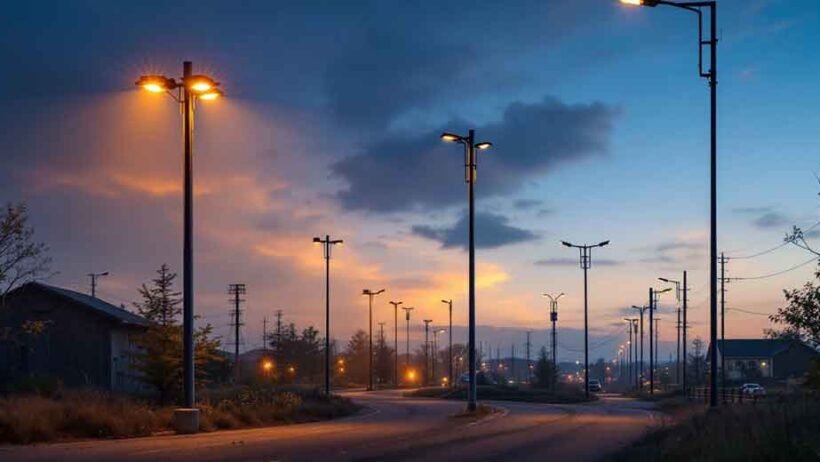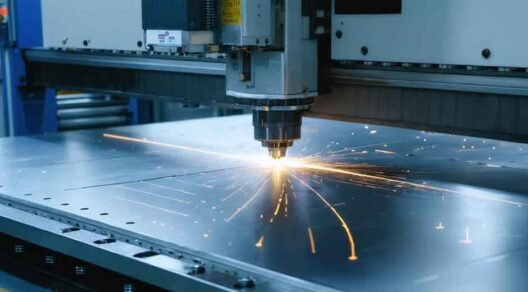When selecting light poles for illumination projects, it’s key to choose poles suited to the specific environment to verify safety and optimal performance. The effectiveness of an outdoor lighting system depends on careful engineering and proper pole selection, including factors like height, material, and foundation. Here are a few factors influencing the selection of light poles for different environments:
Material Composition
The choice of material directly impacts the pole’s durability and suitability for specific environmental conditions. Light poles are made from aluminum, steel, wood, and cast iron. Steel offers high strength and load-bearing capacity. Professionals install steel poles in large roadways and sports complexes to support heavy fixtures. Aluminum is lightweight and naturally resists corrosion. It is suitable for places near water or regions with high humidity. Aluminum poles require relatively low maintenance and are suitable for parks, pedestrian zones, and urban environments. Wood poles blend well with scenic routes and historic sites. You can opt for cast iron pole installation in heritage parks or old town districts, due to their ornate appearance.
Mounting Height
Mounting height is the elevation at which luminaries are installed on the pole. Expansive areas like large parking lots or highways need higher mounting heights for broad light distribution. Lower mounting heights are more suitable for residential streets or pedestrian zones to prevent glare. Professionals offer the following pole designs for different mounting heights:
- Multi-function poles
- Curved aluminum poles
- Round tapered steel poles
- Internal hinged poles
Multi-function poles support communication and lighting technologies in smart city projects that need medium to high mounting heights. Curved aluminum poles offer a decorative look and support moderate mounting heights in commercial districts. Round tapered steel poles can be used for lower mounting heights on smaller streets, while taller versions are appropriate for main roads and open areas. Experts install internal hinged poles in settings where poles must be lowered for repairs or inspections, like airports or industrial facilities. These poles are typically installed at medium mounting heights.
Foundation Type
The foundation provides support and stability to the pole, enabling it to withstand wind and seismic activity. You can choose between direct embedding and anchor bolt installations depending on soil conditions and load requirements. With direct embedding, engineers place the pole directly into a concrete foundation poured into the ground. They use this method for standard installations where the soil is stable and compact, in urban and suburban environments.
Anchor bolt installations involve attaching the pole to steel anchor bolts embedded in a prefabricated foundation. Professionals install anchor bolt foundations in areas with loose soils or places prone to flooding and seismic activity. A separate concrete base with embedded anchor bolts provides additional stability and may be recommended for taller poles or poles supporting heavier fixtures.
Wind Load
Wind load refers to the force that wind exerts on a light pole, affecting its stability. When selecting light poles, professionals assess the wind speed and the presence of nearby structures that can influence the wind load. Poles with octagonal, round, or multi-sided shapes are engineered to withstand high wind loads, making them suitable for open fields or coastal areas. When installing poles with extra features like solar panel mounts or brackets for banners, engineers add reinforcements. During the manufacturing process for these poles, professionals use thick steel and create wide bases to help counter wind load.
Maintenance Needs
Regular maintenance helps promote the longevity and functionality of lighting structures. Light poles made from aluminum resist corrosion, making them ideal for coastal areas and places where the roads are salted in winter. Professionals perform simple cleaning and periodic checks to maintain the surface in good condition. Galvanized steel poles have a protective zinc coating that shields the metal from corrosion. Professionals perform inspections to check the integrity of the coating, which may be exposed to pollution or accidental impact in urban areas. Wood poles need treatments against pests and moisture, as well as checks for cracks or rot in wet or shaded environments. Over time, professionals repaint them or reapply preservatives to prevent decay. Wood poles are best suited for dry environments, often found in rural areas, to minimize moisture-related decay.
Learn More About Light Poles
For custom projects, engineers offer vibration-damping devices for light poles to prevent damage caused by strong winds. Each damper features a bracket for mounting at the top of multi-sided or round cross-sectional poles. These available features, along with many others, may influence a government’s choice of light pole. Contact a reputable infrastructure manufacturer to learn more about their products.








